Barcode programs for SAP systems
Unlike the barcode solutions already integrated in the SAP systems, the RBac programs allow WYSIWYG generation of barcodes with all SAP forms technologies, i.e. “Interactive Forms by Adobe”, “Smart Forms” and the older but still often used “SAPscript”.
Documents with barcodes generated by RBarc can be:
- printed
- faxed
- emailed
- convert to PDF format
- archived
and much more.
The special advantages
- The barcodes are generated as SAP® graphics on-the-fly directly on the SAP® system and appear on SAP® documents not only when they are printed, but also when SAP® documents with barcodes are faxed, emailed, archived or converted to PDF documents.
- No hardware extensions or special barcode printers are needed to output documents with barcodes.
- No installations on SAP® clients are required for barcode output. The installation takes place exclusively on the SAP® Application Server.
- The RBarc programs work independently of the operating system on which the SAP® system has been installed.
RBarc+ for SAP® Systems
RBarc+ is an ABAP program for WYSIWYG output of 1D barcodes on documents. More than 30 barcode symbologies are supported, e.g. Code 39, 2/5 Interleaved or Code GS1-128.
RBarc+ is a 1D barcode generator for ABAP-based SAP® systems, such as R/3, mySAP ERP, SAP ECC, SAP NetWeaver and SAP/4HANA.
RBarc+ is not middleware. It is written in ABAP and is installed once on the SAP® Application Server. Thus, it seamlessly integrates into the SAP® system.
The program can be used with SAPscript, Smart Forms as well as Interactive Forms forms. It comes with a detailed manual and implementation examples in SAPscript, Smart Forms and Interactive Forms.
It can be used for any output type (SAP® device types) and any output path (SAP® access methods) of SAP® documents:
- Printing,
- faxing,
- mailing,
- archiving,
- convert to PDF and much more.
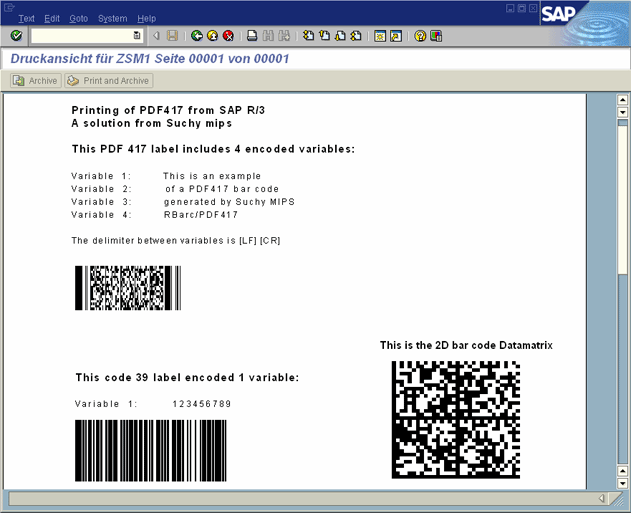
Print preview of a SAP document with barcodes
The following barcode symbologies are supported by RBarc+:
| 2 of 5 interleaved | Code 128 A | MSI (without check sum) | UPC-A |
| 2 of 5 industrial | Code 128 B | MSI + CHK10 | UPC-A+2 |
| 2 of 5 matrix | Code 128 C | MSI+ CHK10+CHK10 | UPC-A+5 |
| 2 of 5 German postal bar code (11 and 13) | Code EAN 128 | MSI+CHK11+CHK10 | UPC-E |
| Code 39 | Code GS1-128 | EAN/JAN 13 | UPC-E+2 |
| Code 39 extended | Code 128 Autoswitch | EAN/JAN 13+2 | UPC-E+5 |
| French postal 39 A/R | Code UCC-128 | EAN/JAN 13+5 | |
| Danish 39 PTT | 128HIBC | EAN/JAN 8 | |
| Code 93 | 128HIBC | EAN/JAN 8+2 | |
| Code 93 extended | 128HIBC Provider Label | EAN/JAN 8+5 |
RBarc/Datamatrix for SAP® Systems
RBarc/Datamatrix is an ABAP program for WYSIWYG output of 2D barcodes of symbology Datamatrix and GS1-Datamatrix (ECC-200) on documents.
RBarc/Datamatrix is a generator of 2D barcodes of the symbology Datamatrix (ECC-200) for ABAP-based SAP® systems, such as R/3, mySAP ERP, SAP ECC, SAP NetWeaver and SAP/4HANA.
RBarc/Datamatrix is not middleware. It is written in ABAP and is installed once on the SAP® Application Server. Thus, it seamlessly integrates into the SAP® system.
The program can be used with SAPscript, Smart Forms as well as Interactive Forms. It comes with a detailed manual and implementation examples in SAPscript, Smart Forms and Interactive Forms.
It can be used for any output type (SAP® device types) and any output path (SAP® access methods) of SAP® documents:
- Printing,
- faxing,
- mailing,
- archiving,
- convert to PDF and much more.
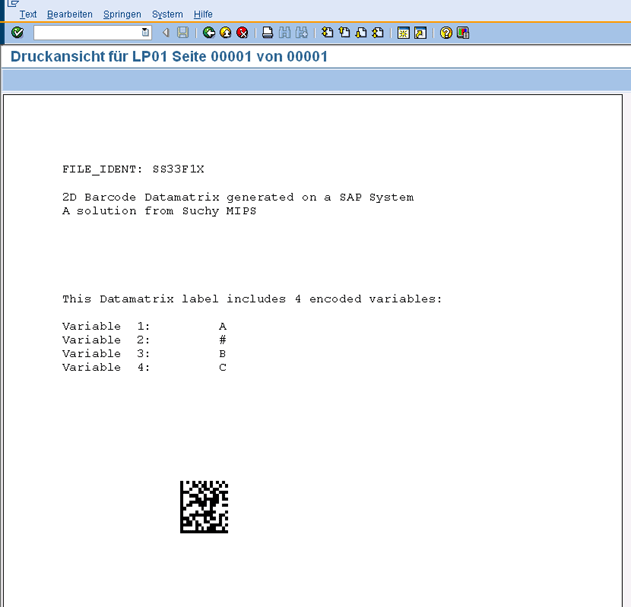
Print preview of a SAP document with barcodes
The program is characterized by the following features:
- RBarc/Datamatrix works independently of the operating system on which the SAP® system has been installed.
- RBarc/Datamatrix works on all ABAP-based SAP® systems, such as R/3, mySAP, SAP® ERP, SAP ECC, NetWeaver.
- RBarc/Datamatrix can be used with SAPscript as well as Smart Forms and Interactive Forms by Adobe.
- RBarc/Datamatrix generates Datamatrix barcodes on-the-fly, within the SAP® system, so that they can be output to all SAP® device types that support graphic output. This includes printers, fax machines, archiving systems, mails, PDF files, etc.
- RBarc/Datamatrix complies with the ISO 16022 standard and supports the following features, among others:
-
Datamatrix symbol standard ECC-200
-
GS1 Datamatrix standard
-
Free choice of module size
-
All 30 symbol versions defined in ISO 16022 related to module composition (also non-square sizes)
-
Automatic check digit calculation according to the Reed-Solomon method
-
Coding of ASCII data, binary data, ASCI-Hex codes and special characters, such as RS. GS, FNC1, 05_Macro and 06_Macro
-
Fixed or automatic selection of barcode size
-
RBarc/Datamatrix was designed in such a way that the program can be used to implement the requirements of various industries, groupings and associations, such as the VDA Association, which go beyond the barcode specification. For example, data can be encoded that cannot be entered via the keyboard but must be encoded at various points in the data stream to meet various specification requirements. These include, for example, the characters FNC1, GS, RS and EOT.
The Datamatrix barcode was developed in the USA in 1989, and is, along with the QR code, one of the most widely used 2D barcodes in industrial applications. It can be found printed on invoices and delivery notes, as stamps or stamped into components of various types, on tools and printed circuit boards. The smallest modules – mostly square – represent bit information.
The Datamatrix barcode is readable in all directions (omnidirectional), so it can be applied to the carrier in any direction. The search pattern is an L-shaped line composed of alternating black and white modules. As the size increases, alignment lines are added to divide the barcode into individual rectangles. The smallest barcode variant consists of one square, while the largest consists of 36 squares separated by the alignment lines.
RBarc/Datamatrix supports all 30 versions defined in ISO standard 16022, which have different size and data capacity. Among the 30 specified sizes, 24 sizes are square and 6 are rectangular. Data capacity of Datamatrix ranges from 3 to 1558 codewords. Codewords are coding units that encode one or more characters depending on the type of data (numeric, alphanumeric, binary or mixed). The data capacity of the Datamatrix code is up to 3116 numeric, 2335 alphanumeric or 1556 binary characters. If different data types are mixed together, then the real encodable data quantity results from a mixed calculation.
With sufficient screen resolution, the barcode generated with RBarc/Datamatrix can be read directly from the SAP® print preview screen using a smartphone and a suitable APP.
The particular advantages of using RBarc/Datamatrix are:
- Seamless integration into the SAP® system
- Support of all SAP® form technologies: SAPscript, Smart Forms and
- Interactive Forms by Adobe
- The possibility of uniform output via various media, such as printers, fax machines, e-mails, PDF files and archiving systems
- The possibility of encoding binary data that cannot be entered via the keyboard (e.g. FNC1, RS, GS, EOT)
- The fact that during the development of the program not only the specifications, but also both the possibilities of electronic output devices and customer requirements were taken into account, thus providing many parameterized design possibilities of the label.
- The central installation on the SAP Application Server
- No client components
- Short installation time
- Easy integration into existing forms
The program can be used with SAPscript, Smart Forms as well as with Interactive Forms forms.
Other features
- Multiple variables from different form locations can be encoded in one barcode Datamatrix label in one step
- The barcode size can be set to a fixed size via parameters – independent of the number of data to be encoded
- The encoding of characters that cannot be visually represented in the SAP® system is fully supported. This makes the program especially suitable for the implementation of the electronic postage stamp with Datamatrix of Deutsche Post AG.
- Together with special reports the program is particularly suitable for the implementation of an EDI mark on documents
- RBarc/Datamatrix guarantees the fulfilment of all necessary specification features for the automotive sector
RBarc/QR-Code for SAP® Systems
RBarc/QRCode is an ABAP program for WYSIWYG output of 2D barcodes of symbology QRCode (Model 2) and Swiss-QR on documents.
RBarc/QRCode is a generator of 2D barcodes of symbology QRCode (Model 2) for ABAP based SAP® systems like R/3, mySAP ERP, SAP ECC, SAP NetWeaver and SAP/4HANA.
RBarc/QRCode is not middleware. It is written in ABAP and is installed once on the SAP® Application Server. Thus, it seamlessly integrates into the SAP® system.
The program can be used with SAPscript, Smart Forms as well as Interactive Forms. It comes with a detailed manual and implementation examples in SAPscript, Smart Forms and Interactive Forms.
It can be used for any output type (SAP® device types) and any output path (SAP® access methods) of SAP® documents:
- Printing,
- faxing,
- mailing,
- archiving,
- convert to PDF and much more.
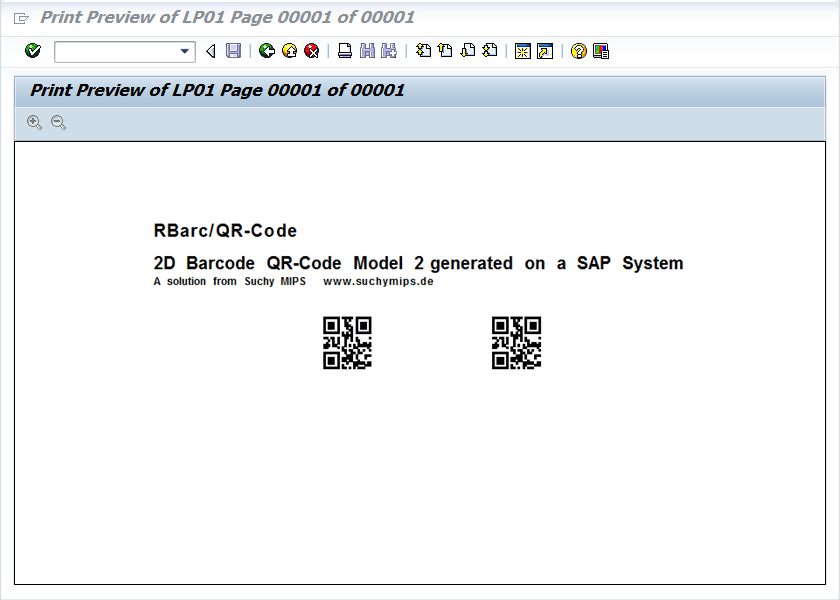
Print preview of a SAP document with barcodes
The program is characterized by the following features:
- RBarc/QRCode works independently of the operating system on which the SAP® system has been installed.
- RBarc/QRCode works on all ABAP-based SAP® systems, such as R/3, mySAP, SAP ERP, SAP ECC, SAP NetWeaver and SAP/4HANA
- RBarc/QRCode can be used with SAPscript as well as Smart Forms and Interactive Forms (Adobe Forms)
- RBarc/QRCode generates QR Code barcodes on-the-fly, within the SAP® system, so they can be output to all SAP® device types that support graphic output. This includes printers, fax machines, archiving systems, mails, PDF files, etc.
- RBarc/QRCode adheres to the AIM International Technical Specification and ISO/IEC 18004:2006 standard and supports the following features, among others:
- QR Code Symbol Model 2
- Integrated support of Swiss QR Code
- Free choice of module size
- All 40 symbol versions defined in ISO standard related to module composition
- Automatic check digit calculation according to the Reed-Solomon method
- Encoding of ASCII data, binary data, ASCI Hex codes, Unicode (multibyte codes) and Kanji characters
- Extended Channel Interpretation (ECI)
- FNC1 at first and second position
- 4 Error Correction Levels (L, M, Q and H) for each version
- Fixed or automatic selection of version, depending on data volume
RBarc/QRCode has been designed to meet the requirements of various industries, groups and associations that go beyond the barcode specification. For example, data can be encoded that cannot be entered from the keyboard, but must be encoded at various points in the data stream to meet various specification requirements. These include, for example, the characters FNC1, GS, RS, and EOT.
The QR Code was developed in Japan in 1994 with the aim of providing a barcode with high data capacity and very fast readability (QR = Quick Response). Another important goal was to enable the encoding of the Kanji characters used in Japan. In fact, QR Code is the only barcode that reliably encodes not only Kanji, but also special characters from the Latin script, such as the German umlauts, and is also reproduced as such by reading devices. With sufficient screen resolution, the barcode generated with RBarc/QRCode can be read directly from the SAP print preview screen using a smartphone and a suitable APP.
All QR Code labels are square. The smallest modules – also square – represent bit information. The QR Code is readable in all directions (omni-directional), so it can be placed on the carrier in any direction. Characteristic, framed squares in three corners of a QR Code label serve as search patterns. In addition, the QR Code is provided with so-called timing and alignment patterns, the number of which increases as the size of a QR Code increases. The timing lines and different numbers of alignment patterns allow reliable reading even of distorted barcodes. As a result, all standard printing technologies can be used for printing QR codes and the barcode can be printed not only on documents but also on various types of containers.
RBarc/QRCode supports all 40 versions defined in the official specification, which have different size and data capacity – between 26 and 3706 codewords. Codewords are encoding units that encode one or more characters depending on the type of data (numeric, alphanumeric, binary or mixed). The data capacity of the QR Code is up to 7089 numeric, 4296 alphanumeric or 1817 binary characters. If different data types are mixed together, then the real encodable amount of data results from a mixed calculation.
The particular advantages of using RBarc/QRCode are:
- Seamless integration into the SAP® system
- Support of all SAP® form technologies: SAPscript, Smart Forms and Interactive Forms by Adobe
- The possibility of uniform output via various media, such as printers, fax machines, e-mails, PDF files and archiving systems
- The possibility of encoding binary data that cannot be entered via the keyboard (e.g. FNC1, RS, GS, EOT)
- Support of multibyte (Unicode) characters (e.g. German umlauts) of the output devices as well as customer requirements have been taken into account and thus there are many parameterized design possibilities of the label
- The central installation on the application server
- No client components
- Short installation time
- Easy integration into existing forms
Other properties:
- Multiple variables from different form locations can be encoded into one step in a QR code label.
- The barcode size can be set to a fixed size via parameters – independent of the number of data to be encoded.
- The encoding of characters that cannot be represented in the SAP® system, such as: Function code RS, GS, EOT is possible. Also non-Latin characters, such as Cyrillic, Kanji, Thai or diacritical characters, such as: German umlauts can be encoded.
RBarc/OMR for SAP® Systems
RBarc/OMR is an ABAP program for WYSIWYG output of OMR barcodes on documents for the purpose of controlling enveloping machines.
RBarc/OMR is a barcode generator for OMR (Optical Mark Recognition) barcodes for ABAP-based SAP® systems, such as R/3, mySAP ERP, SAP ECC, SAP NetWeaver and SAP/4HANA.
RBarc/OMR is not middleware. It is written in ABAP and is installed once on the SAP® Application Server. Thus, it seamlessly integrates into the SAP® system.
The program can be used with SAPscript, Smart Forms as well as Interactive Forms. It comes with a detailed manual and implementation examples in SAPscript, Smart Forms and Interactive Forms.
It can be used for any output type (SAP® device types) and any output path (SAP® access methods) of SAP® documents:
- Printing,
- faxing,
- mailing,
- archiving,
- convert to PDF and much more.
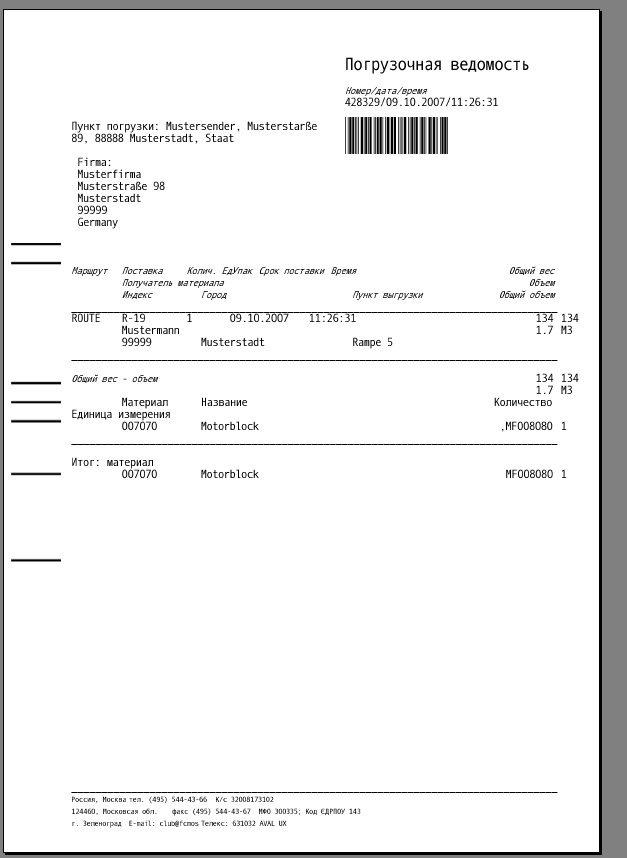
Print preview of a SAP document with barcodes
RBarc/PDF417 for SAP® Systems
RBarc/PDF417 is an ABAP program for WYSIWYG output of stacked barcodes of PDF417 symbology on documents.
RBarc/PDF417 is a generator of stacked barcodes of PDF417 symbology for ABAP based SAP® systems, such as R/3, mySAP ERP, SAP ECC, SAP NetWeaver and SAP/4HANA.
RBarc/PDF417 is not middleware. It is written in ABAP and is installed once on the SAP® Application Server. Thus, it seamlessly integrates into the SAP® system.
The program can be used with SAPscript, Smart Forms as well as Interactive Forms. It comes with a detailed manual and implementation examples in SAPscript, Smart Forms and Interactive Forms.
It can be used for any output type (SAP® device types) and any output path (SAP® access methods) of SAP® documents:
- Printing,
- faxing,
- mailing,
- archiving,
- convert to PDF and much more.
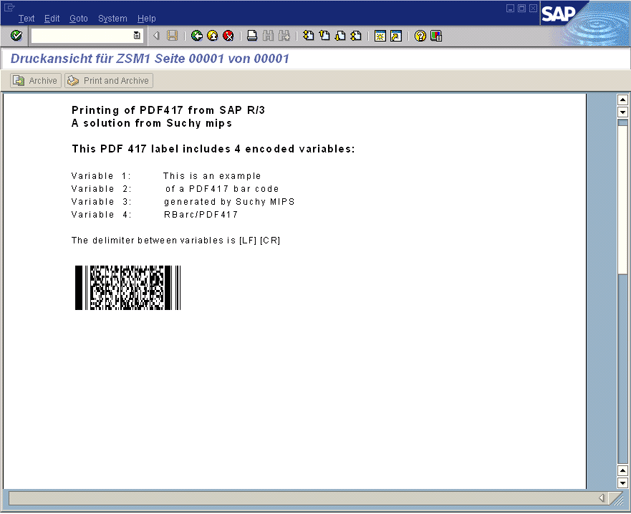
Print preview of a SAP document with barcodes
The program is characterized by the following features:
- RBarc/PDF417 works independently of the operating system on which the SAP® system has been installed.
- RBarc/PDF417 works on all ABAP-based SAP® systems, such as R/3, mySAP, SAP ERP, SAP ECC, SAP NetWeaver and SAP/4HANA
- RBarc/PDF417 can be used with SAPscript as well as Smart Forms and Interactive Forms (Adobe Forms)
- RBarc/PDF417 generates PDF417 barcodes on-the-fly, within the SAP® system, so they can be output to all SAP® device types that support graphic output. This includes printers, fax machines, archiving systems, mails, PDF files, etc.
- RBarc/PDF417 complies with ISO standard ISO/IEC 15438
- Free choice of the number of rows and columns
- Free choice of module size
- Automatic check digit calculation according to the Reed-Solomon method
- Encoding of ASCII data, binary data, ASCI hex codes
- 9 Error Correction Levels
- Fixed or automatic selection of the version, depending on the amount of data.
- RBarc/PDF417 has been designed to meet the requirements of various industries, groups and associations that go beyond the barcode specification. For example, data can be encoded that cannot be entered from the keyboard, but must be encoded at various points in the data stream to meet various specification requirements. These include, for example, the characters FNC1, GS, RS and EOT.
- The PDF417 barcode was developed in 1991 by Symbol Technologies, namely by Ynjiung Wang. The newly developed symbology aimed to provide a larger data capacity than 1D barcodes. In addition, the barcode offers not only error detection but also error correction by calculating check and correction numbers according to the Reed-Solomon method.
The capacity of the barcode is a maximum of 925 codewords, which means that a maximum of the following amounts of data can be encoded:
1850 characters (2 characters per codeword) in the so-called Text Compaction Mode
1108 bytes (1.2 bytes per codeword) in the so-called Byte Compaction Mode
2710 numeric characters in the so-called Numeric Compaction Mode (2.93 characters per codeword).
The particular advantages of using RBarc/PDF417 are:
- Seamless integration into the SAP® system
- Support of all SAP® form technologies: SAPscript, Smart Forms and
- Interactive Forms by Adobe
- The possibility of uniform output via various media, such as printers, fax machines, e-mails, PDF files and archiving systems
- The ability to encode binary data that cannot be entered via keyboard (e.g. FNC1, RS, GS, EOT)
- The support of multibyte (Unicode) characters (e.g. umlauts)
- The fact that during the development of the program not only the specifications, but also the possibilities of electronic output devices as well as customer requirements were taken into account, and thus there are many parameterized design possibilities of the label
- The central installation on the application server
- No client components
- Short installation time
- Simple integration into existing forms
Other features:
- Multiple variables from different form locations can be encoded in one barcode PDF-417 label in one step
- The barcode size can be set to a fixed size via parameters – independent of the number of data to be encoded
- Encoding of characters that cannot be represented in the SAP® system, such as FNC1, is fully supported
Which RBarc programs are available?
There are the following programs of the RBarc series:
- RBarc+: all supported 1D barcodes
- RBarc Datamatrix: Datamatrix ECC-200 code, GS1 Datamatrix
- RBarc/PDF417 : PDF417 code
- RBarc/QR Code: QR code Model 2
- RBarc/OMR : OMR code
Which barcodes can be generated with the RBarc programs?
RBarc+ generates most standard 1D barcode symbologies, e.g.:
- Code 128, GS1-128, Code 39, 2 out of 5 Interleaved, etc.
- RBarc/Datamatrix generates the 2D barcode Datamatrix ECC-200, or GS1 Datamatrix
- RBarc/QRCode generates the 2D barcode QR code Mode 2 and the Swiss-QR code
- RBarc/PDF417 generates the stacked 2D barcode PDF417
- RBarc/OMR generates the OMR code for controlling printing machines
What makes RBarc different from other barcode programs?
All RBarc programs are written in ABAP. The on-the-fly generated barcode graphics are immediately inserted into the documents. Documents that receive a barcode generated with RBarc can not only be printed directly from the SAP system, but also faxed, emailed or converted to PDF format. The barcodes are also retained during archiving, so that no special printing device needs to be kept on hand for later reprinting.
Are RBarc programs part of the middleware?
No, the RBarc programs are not middleware. Programs of the RBarc series fit seamlessly into the SAP system.
How to install RBarc?
The installation is done in a few steps exclusively on the SAP application server. The administrator creates a package in which he installs the delivered reports and includes. No transport request is delivered, but the ABAP source codes.
Do I need to create tables in the SAP database for the installation of RBarc?
No. All programs in the RBarc series do not require database tables.
Are client components required to install and use RBarc?
No. None of the RBarc programs use client components. Installation is done exclusively on the SAP application server.
Are printer extensions needed for printing barcodes with RBarc?
No. No printer extensions are required for printing barcodes with RBarc series programs. The barcodes can be printed on any graphics-capable printer, similar to logos, for example.
How much time is needed to install RBarc?
If all permissions are in place, installation and testing should take no more than 30-60 minutes.
Is there a trial version of the RBarc programs?
Yes, with the exception of RBarc/OMR, free trial versions of all RBarc programs are available in the download area of www.suchymips.de.
What is the difference between a RBarc trial version and a RBarc full version?
RBarc+ generates in the test version only a code 39 and exchanges the 0 with the 9.
RBarc/Datamatrix, RBarc/QRCode and RBarc/PDF417 allow printing barcodes with only a few test data.
All test versions of the RBarc programs are designed in such a way that basically all functions offered by the programs can be tested. The restrictions only concern the barcode symbology or its characteristics.
The test versions may only be used in the test environment and not in the productive environment.
We need to print the barcode GS1-128, formerly EAN-128 with FNC1. Which RBarc program is suitable for this?
RBarc+ explicitly supports the code GS1-128 with all properties specified by GS1. This includes the FNC1 in second position and as separator symbol for data fields.
We need to print VDA labels with Datamatrix. The labels contain characters that cannot be typed with the keyboard. Can this be done with RBarc/Datamatrix?
All RBarc programs are designed to encode all special characters supported by the symbologies, such as <RS>, <GS>, <EOT>, <FNC1>, etc. You can learn more about this from the manual which, among others, is also included with each trial version. You can get the trial version in the download area of www.suchymips.de.
Can I freely choose the parameters of the barcodes in the RBarc programs?
All parameters defined by the respective ISO specification are supported by the RBarc programs. For 1D barcodes these are e.g. width of bars and gaps, barcode height, choice of a check digit, etc. For 2D barcodes these are module size, error correction level (ECC level), etc.
Does RBarc/Datamatrix support the ECC-200 standard?
Yes, RBarc/Datamatrix supports the ECC-200 standard.
Can barcodes be positioned side by side? Also with SAPscript?
Yes, barcodes in documents can also be positioned next to each other. Also with SAPscript.
How to encode a variable that does not represent any representable characters (e.g. the binary value '00')?
The corresponding procedure is described in the respective manual.
Can barcodes be positioned in the Main window of a SAPscript form?
Yes, barcodes can be positioned in the Main window as well as in another window of a SAPscript form.
Are there manuals for the RBarc programs?
Yes. For each program of the RBarc series there is a detailed manual in English and German. Sample implementations in SAPscript, Smart Forms and Interactive Forms are supplied with each program, making it easy to quickly get started printing barcodes with RBarc.
Which printer connection types (connection types) can be used for printing barcodes with RBarc?
The printing of barcodes with programs of the RBarc series is not affected by the choice of the printer connection type. Therefore, any connection type can be used.
What types of devices can or must be used for printing barcodes with RBarc?
Basically, any device type that is capable of generating graphics can be used. This includes all device types that are based on the drivers for PCL, Postscript and Prescribe. SAPWIN can also be selected as the device type. Only a few device types available for old line printers do not support graphics.
Tip: If a graphic (e.g. the company logo) can be printed with a device type, then barcodes generated with RBarc can also be printed with this device type.
How can I check in advance if barcodes will work with RBarc and the types of devices we use?
Save a small graphic in the SAP® system (e.g. the company logo) and print it. If the graphic is printed, then barcodes generated with RBarc will also be printed.
Does RBarc work after an update of the SAP system?
All RBarc programs are installed in the Z-area and are not affected by the update. They will work even after the update.
We print on labels with SAPscript by defining the Main window multiple times on a page. Does this also work with RBarc?
Yes, it works with RBarc. The barcode definition can be placed in the Main window and the window can be defined multiple times on one page.
How can I print the check digit in human readable text with RBarc+?
The check digit calculated by RBarc+ is returned as a parameter to the form (as of vers. 2010), so that it can be printed in the human readable text line.
With which resolution are the barcodes graphics generated?
A separate parameter is provided for the graphic resolution. Using this parameter, it is possible to determine the resolution of the graphic either globally or individually for each defined barcode. Thus all conceivable resolutions are realizable, e.g. 150 dpi, 200 dpi, 300 dpi or 600 dpi.
Some SAP variables start with spaces or leading zeros that you do not want to encode in the barcode. Is there a solution for this?
As of Vers. 2010 there is the parameter “Input_handling”. With this parameter the text to be coded can be influenced. The following options are currently implemented:
- Deletion of leading zeros
- Deletion of leading blanks
- Deletion of invalid characters
- All possible combinations of 1, 2 and 3
Can barcodes with human readable text be output rotated?
RBarc+2010 comes with special fonts that make it possible to output human readable text lines together with the barcode in rotated form. This applies to both SAPscript and SmartForms.
How to code a variable that has spaces at the end. For example, if I pass 'ABC ', the spaces after the "C" are lost.
ABAP does not take into account the spaces at the end of a variable (neither of type c nor of type string). However, the blanks can be passed to RBarc/Datamatrix in ASCII hex form and thus be encoded. You can read more about this in the manual.
Are programs of the RBarc series Unicode capable?
Yes, from version 2007 all programs of the RBarc series are Unicode capable.
The EAN-128 barcode generates an FNC1 character automatically after the start character. How can I add more FNC1 characters to the barcode?
To do this, add the character ‘í’ ((ALT+0161) to the variable you want to encode.
RBarc+ supports the following non-printable character codes for the “Code 128” family:
- <FNC1>, <FNC2> <FNC3>, and <SHIFT>.
Use the following ASCII characters to generate these codes: - <FNC1> = ASCII character 237 = 0xED = ( “í” or ALT + 161 ).
- <FNC2> = ASCII character 243 = 0xF3 = ( “ó” or ALT + 162 ).
- <FNC3> = ASCII character 250 = 0xFA = ( “ú” or ALT + 163 ).
- <SHIFT> = ASCII character 241 = 0xF1 = ( “ñ” or ALT + 164 )
e.g. to separate the values A = ‘111’ and B =’ 222′ with FNC1 use the value C = ‘111í222.’
How accurately can barcodes be positioned?
That depends on the units of measurement used. As a rule, the accuracy goes to 2 decimal places, e.g. 0.01 mm.
Can different versions of RBarc run parallel on one SAP system?
Yes, they can. The RBarc programs have been designed so that the names of the corresponding includes do not collide with each other. Thus, a new version can be tested without affecting the previous version.
Although I leave the check digit parameter W_CHKSUM empty, a check digit is generated. What am I doing wrong?
The W_CHKSUM parameter only has an effect on barcodes where the check digit is not mandatory. This includes e.g. Code 39 and 2/5 Interleaved. Most barcode symbologies, such as Code 128, EAN, Code 93, etc. have mandatory check digits that cannot be disabled.
Which parameter is used to control the barcode width?
You can find the information in the manual.


